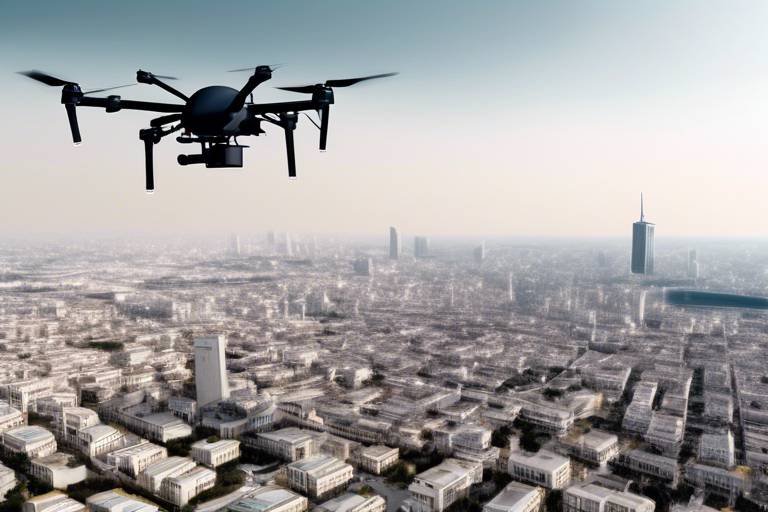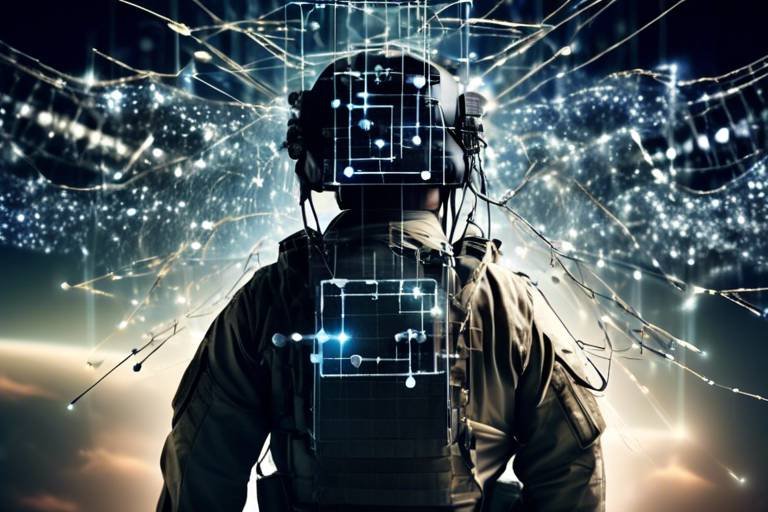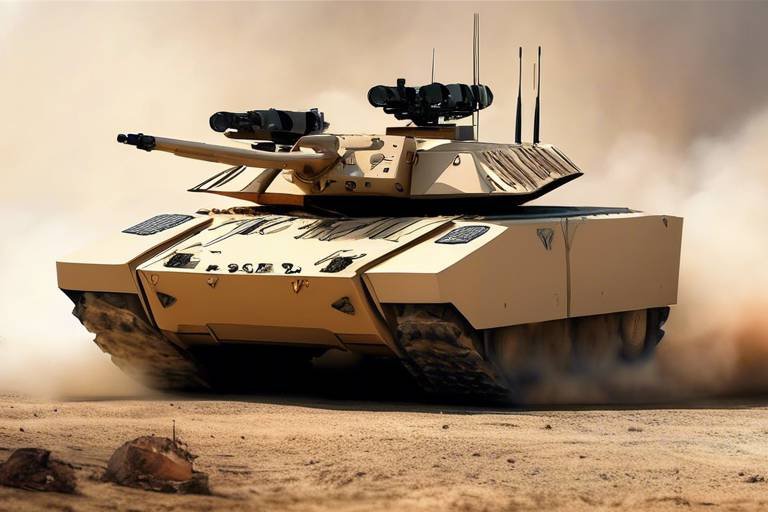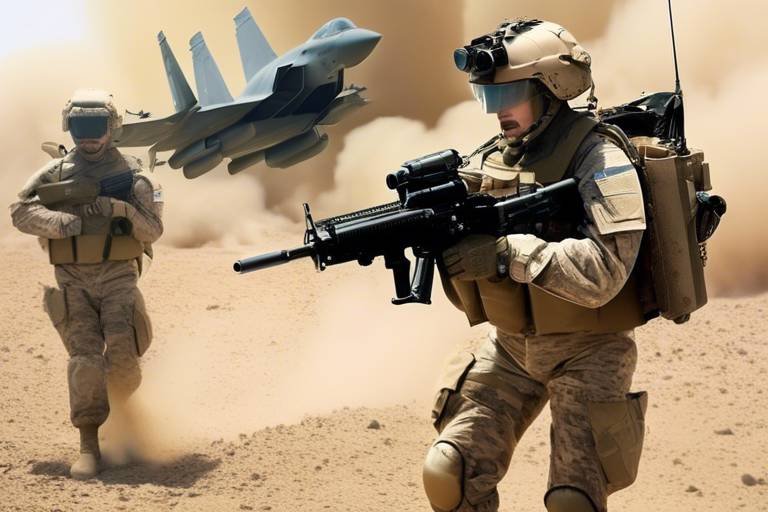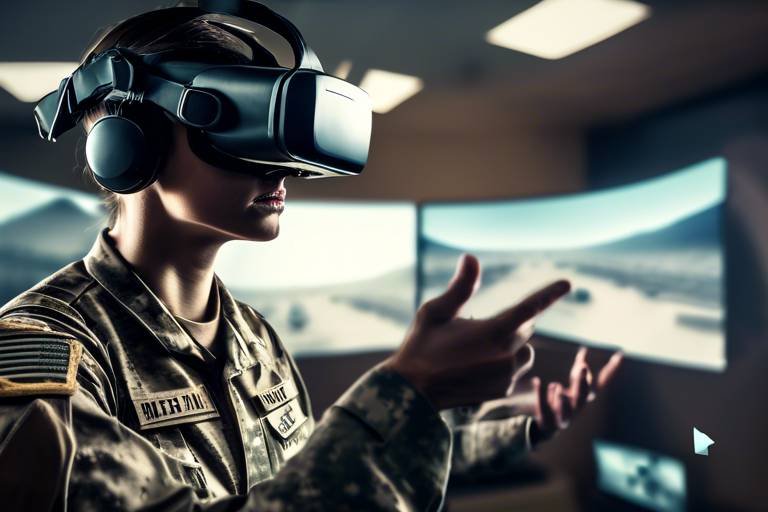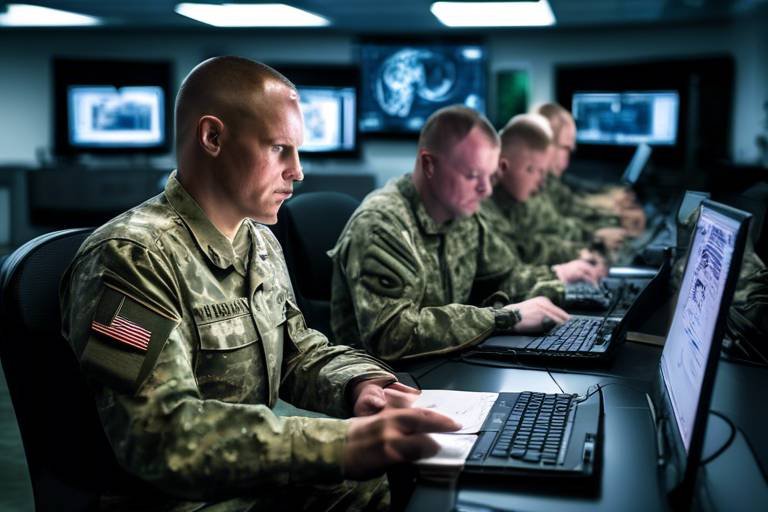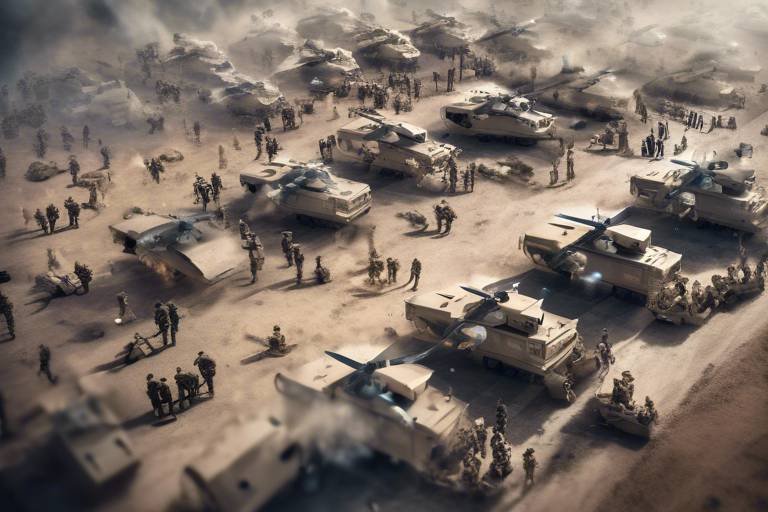AI-Driven Anti-Drone Technologies - Protecting Airspace
In an age where technology evolves at lightning speed, drones have emerged as both a boon and a bane. While they offer innovative solutions in various sectors, from delivery services to aerial photography, their increasing accessibility has also given rise to a host of security threats. This is where AI-driven anti-drone technologies step in, acting as a crucial line of defense for our skies. Imagine a world where unauthorized drones are swiftly detected and neutralized before they can pose a risk—this is not just a futuristic dream, but a reality being shaped by cutting-edge artificial intelligence.
The significance of these technologies cannot be overstated. As drones become more sophisticated, so do the methods to counteract them. The potential for drones to be used in malicious activities, such as spying, smuggling, or even terrorist attacks, necessitates a robust response. With airspace becoming increasingly crowded, the need for advanced solutions to ensure safety and security in both urban and rural environments is paramount. AI-driven systems offer unparalleled advantages, enabling real-time analysis and response that human operators simply cannot match.
Furthermore, the integration of AI in anti-drone systems allows for a more proactive approach. These technologies are not just reactive; they can anticipate threats based on patterns and behaviors learned from vast datasets. Consider the analogy of a seasoned chess player who can predict their opponent's moves. Similarly, AI can analyze drone flight paths and predict potential threats, providing a tactical advantage in safeguarding airspace.
As we delve deeper into the world of AI-driven anti-drone technologies, we'll explore the various components that make these systems effective, including detection methods, machine learning algorithms, and the ethical considerations that accompany their deployment. The journey to secure our skies is complex, but with the right tools and understanding, we can navigate it successfully.
- What are AI-driven anti-drone technologies?
These are advanced systems that utilize artificial intelligence to detect, track, and neutralize unauthorized drones, ensuring the safety of airspace.
- How do these technologies detect drones?
AI-driven systems use various methods, including radar, radio frequency (RF) sensing, and computer vision, to identify drone activities.
- What role does machine learning play in these systems?
Machine learning algorithms help differentiate between benign and malicious drones, enhancing decision-making processes.
- Are there privacy concerns associated with anti-drone technologies?
Yes, the use of surveillance technologies raises privacy issues, necessitating a balance between security needs and individual rights.
- How do international regulations affect the deployment of these technologies?
Different countries have varying regulations regarding drone usage and countermeasures, impacting the development and implementation of anti-drone technologies.

Understanding Drone Threats
Drones, once a novelty, have rapidly evolved into a ubiquitous presence in our skies. While many people use them for recreational activities, aerial photography, and even delivery services, the rise of drones brings along a host of potential threats that cannot be ignored. These threats can range from privacy invasions to serious security breaches. For instance, imagine a drone hovering over a crowded event, capturing images without consent, or worse, carrying harmful payloads. The implications of such scenarios are profound, making it crucial to understand the various types of drone threats that necessitate advanced countermeasures.
One of the most alarming threats posed by drones is their potential use in terrorism. Unmanned aerial vehicles (UAVs) can be modified to carry explosives, making them a tool for malicious actors to target crowded places or critical infrastructure. This has led to increased concerns among governments and security agencies about the need for effective detection and neutralization systems. Additionally, drones can be employed for espionage, providing unauthorized surveillance capabilities that can compromise national security or corporate secrets.
Moreover, the commercial sector is not immune to drone threats. Competitors can use drones to spy on business operations, gather sensitive information, or disrupt logistics. This has prompted many companies to invest in anti-drone technologies to protect their assets. The risks extend beyond corporate espionage; drones can also interfere with aviation safety. Incidents of drones colliding with manned aircraft have been reported, leading to serious safety concerns for pilots and passengers alike. With air traffic increasing, the need for effective countermeasures is more pressing than ever.
To encapsulate the variety of drone threats, we can categorize them into the following groups:
- Terrorism: Drones used to deliver explosives or conduct attacks.
- Espionage: Unauthorized surveillance of individuals or organizations.
- Commercial Threats: Corporate espionage and disruption of business operations.
- Aviation Safety: Risks posed by drones to manned aircraft.
As we delve deeper into the world of drones, it becomes evident that the implications of their use are far-reaching. The increasing accessibility of drone technology means that more individuals and groups can exploit these devices for malicious purposes. Therefore, understanding the nature of these threats is essential for developing effective countermeasures. It is not just about protecting airspace; it is about safeguarding our privacy, security, and the integrity of our operations in various environments.
- What types of drones pose the greatest threat? Drones used for terrorism, espionage, and those that interfere with aviation safety are considered the most dangerous.
- How can organizations protect themselves from drone threats? Investing in anti-drone technologies, enhancing surveillance, and implementing strict security protocols can help mitigate risks.
- Are there regulations governing drone usage? Yes, regulations vary by country and often include restrictions on where and how drones can be operated.

AI Technology in Countermeasures
Artificial Intelligence (AI) is revolutionizing the way we approach security in our skies. As the proliferation of drones continues to rise, so does the need for effective countermeasures. AI technology plays a pivotal role in enhancing these systems, making them smarter and more efficient. Imagine a world where our airspace is monitored by intelligent systems that can swiftly identify and neutralize threats. Sounds like science fiction, right? But it's becoming a reality!
At the heart of AI-driven anti-drone systems is the ability to detect, track, and neutralize unauthorized drones with incredible precision. These systems utilize a combination of advanced algorithms and real-time data processing to ensure that responses to drone threats are not only swift but also accurate. The integration of AI enables these systems to learn from past encounters, continuously improving their effectiveness.
One of the key aspects of AI technology in countermeasures is its ability to analyze vast amounts of data from various sensors. For instance, when a drone is detected, the system can pull information from radar, radio frequency (RF) sensors, and even visual cameras to create a comprehensive picture of the situation. This is where data fusion techniques come into play. By merging data from multiple sources, AI can enhance situational awareness, allowing operators to make informed decisions quickly.
Moreover, the use of machine learning algorithms is crucial for distinguishing between benign and malicious drones. These algorithms are trained using vast datasets, enabling them to recognize patterns and behaviors specific to different types of drones. For example, a hobbyist's drone flying in a park would exhibit different flight characteristics compared to a drone being used for surveillance. By understanding these nuances, AI systems can reduce false positives and focus their attention on genuine threats.
As we delve deeper into the world of AI technology in countermeasures, it's essential to highlight the various detection methods employed. These include:
- Radar Systems: Utilizing radio waves to detect objects in the air.
- RF Sensing: Monitoring radio frequencies to identify drone communications.
- Visual Recognition: Employing cameras equipped with AI to visually identify drones.
Each of these detection methods contributes to a layered defense strategy, ensuring that no drone goes unnoticed. Once a potential threat is identified, the system can initiate neutralization techniques such as jamming the drone's signal or deploying interceptor drones to take down the unauthorized craft safely.
In conclusion, AI technology is not just a tool; it's a game-changer in the realm of anti-drone countermeasures. By leveraging advanced algorithms and sophisticated detection methods, we can create a secure airspace that protects both individuals and property. As the technology continues to evolve, the future of airspace security looks promising, ensuring that we stay one step ahead of potential threats.
- What are the main benefits of AI in anti-drone technologies?
AI enhances detection accuracy, improves response times, and reduces false alarms, making airspace security more efficient. - How does machine learning improve drone detection?
Machine learning algorithms analyze flight patterns to differentiate between harmless and potentially harmful drones. - Are there privacy concerns with AI-driven anti-drone systems?
Yes, the use of surveillance technologies raises privacy issues, necessitating a balance between security and individual rights. - What are the challenges in implementing these technologies?
Regulatory hurdles and varying international laws can complicate the deployment of AI-driven countermeasures.

Detection Methods
In the ever-evolving landscape of drone technology, the need for effective detection methods is more crucial than ever. Drones can be both a boon and a bane, serving various purposes from recreational use to commercial applications. However, with their increasing accessibility, the potential for misuse has also surged. This is where AI-driven detection methods come into play, revolutionizing how we identify and respond to unauthorized drone activities.
One of the primary methods employed for drone detection is radar technology. Traditional radar systems have long been used in aviation to track aircraft, but they have been adapted to detect smaller, less detectable objects like drones. By utilizing advanced signal processing techniques, these radar systems can differentiate between various flying objects, significantly improving detection rates. However, radar alone may not suffice in complex environments, which is where Radio Frequency (RF) sensing steps in.
RF sensing works by monitoring the radio signals emitted by drones. Since most drones rely on communication between the drone and its operator, intercepting these signals provides a clear indication of their presence. By employing AI algorithms, systems can analyze the patterns of these signals and determine whether they belong to a benign recreational drone or a potentially malicious entity. This dual approach of using both radar and RF sensing creates a robust framework for detection.
To further enhance detection capabilities, AI systems utilize machine learning algorithms. These algorithms are designed to learn from vast amounts of data, allowing them to identify patterns and anomalies associated with drone behavior. For instance, a machine learning model can be trained to recognize the typical flight paths of commercial drones, enabling it to flag any deviations that may indicate suspicious activity. The ability to adapt and learn in real-time makes these AI systems exceptionally effective in dynamic environments.
Moreover, the integration of data fusion techniques plays a pivotal role in improving situational awareness. By combining data from multiple sensors—such as radar, RF, and even optical cameras—AI systems can create a comprehensive picture of the airspace. This holistic view not only enhances the accuracy of threat assessments but also speeds up the response time to potential drone threats. Imagine trying to solve a puzzle; the more pieces you have, the clearer the picture becomes. That’s precisely how data fusion works in the realm of drone detection.
In summary, the detection methods employed in AI-driven anti-drone technologies are multifaceted and highly sophisticated. By leveraging a combination of radar, RF sensing, machine learning, and data fusion techniques, these systems are equipped to identify and assess drone threats with remarkable precision. As the drone landscape continues to evolve, so too will the technologies designed to protect our airspace.
- What types of drones can be detected using these methods?
Most detection methods are designed to identify a wide range of drones, from small recreational models to larger commercial units. The effectiveness can vary based on the size and technology of the drone.
- How do AI algorithms improve detection accuracy?
AI algorithms analyze vast amounts of data to identify patterns and anomalies, allowing them to distinguish between normal drone activities and potential threats more effectively.
- Are there any limitations to current detection methods?
Yes, factors such as environmental conditions, the presence of other electronic devices, and the design of the drone can affect detection capabilities. Continuous advancements in technology aim to address these limitations.

Machine Learning Algorithms
When it comes to combating drone threats, are the unsung heroes behind the scenes. These algorithms are designed to analyze vast amounts of data and make real-time decisions that can mean the difference between safety and disaster. Imagine trying to find a needle in a haystack; now, think of how much easier that task becomes when you have a magnet! This is essentially what machine learning does for anti-drone technologies—it helps identify potential threats swiftly and accurately.
At the core of these algorithms is the ability to learn from past experiences. By feeding the system data from previous drone encounters, it becomes adept at recognizing patterns that distinguish between benign drones—like those used for photography or recreational flying—and malicious drones that may pose a threat. This capability is crucial because, in many cases, the difference between a harmless drone and a potential threat can be subtle.
One fascinating aspect of machine learning is the use of supervised learning techniques, where the algorithm is trained on labeled datasets. For instance, if we provide the system with images of various drones along with their classifications, it can learn to identify new drones based on their features. This process is akin to teaching a child to recognize different animals by showing them pictures and explaining the characteristics of each one. Over time, the algorithm becomes more proficient, improving its detection accuracy.
Moreover, machine learning algorithms can also employ unsupervised learning methods, where they analyze data without pre-existing labels. This approach can uncover hidden patterns or anomalies that might not be immediately apparent. For example, if a drone is flying in a restricted area, the algorithm can flag this behavior even if it has never seen that specific drone before. It’s like having a security guard who, even without a list of known criminals, can sense when someone is acting suspiciously.
To further enhance the decision-making process, these algorithms often utilize ensemble methods. This technique combines the predictions of multiple models to achieve a more robust outcome. Think of it as a group of friends debating where to eat; each person brings their own perspective, and together they reach a consensus that everyone is happy with. In the same way, ensemble methods ensure that the final decision regarding a drone threat is well-rounded, reducing the chances of false positives or negatives.
In addition to detection, machine learning algorithms also play a vital role in the tracking and neutralization of drones. Once a potential threat is identified, the system can predict the drone's trajectory and recommend appropriate countermeasures. This predictive capability is essential in dynamic environments where every second counts. For instance, if a drone is heading towards a sensitive facility, the system can quickly calculate the best course of action—be it jamming the signal, deploying a net, or alerting security personnel—based on the drone's speed and direction.
In conclusion, machine learning algorithms are a cornerstone of modern anti-drone technologies, enabling systems to differentiate between various types of drones and respond appropriately. As these algorithms continue to evolve, we can expect even greater advancements in our ability to protect airspace from unauthorized intrusions. The future of drone defense is not just about technology; it’s about intelligent technology that learns and adapts to new challenges.
- What are machine learning algorithms? - Machine learning algorithms are computational methods that allow systems to learn from data and improve their performance over time without being explicitly programmed.
- How do machine learning algorithms help in anti-drone technologies? - They enhance the detection, tracking, and neutralization of unauthorized drones by identifying patterns and making real-time decisions based on data.
- What is the difference between supervised and unsupervised learning? - Supervised learning involves training a model on labeled data, while unsupervised learning analyzes data without predefined labels to find hidden patterns.
- Can machine learning algorithms reduce false positives in drone detection? - Yes, by using ensemble methods and continuous learning, these algorithms can significantly improve accuracy and reduce false alarms.

Data Fusion Techniques
When it comes to countering drone threats, are a game-changer. Imagine trying to piece together a jigsaw puzzle where each piece represents data from different sensors. Alone, each piece might not reveal much, but when combined, they create a complete picture of the airspace. This is precisely what data fusion does in the realm of anti-drone technologies. By integrating information from various sources—be it radar systems, radio frequency (RF) sensors, or even optical cameras—these techniques enhance situational awareness significantly.
At the heart of data fusion is the ability to process and analyze vast amounts of data in real-time. For instance, consider a scenario where multiple drones are flying in a restricted area. One sensor might detect a drone's presence, while another could provide information about its altitude and speed. When these data points are fused together, the system can create a comprehensive threat assessment that helps operators make informed decisions quickly.
Furthermore, data fusion techniques can employ advanced algorithms to filter out noise and irrelevant information, allowing for a clearer understanding of potential threats. This is particularly crucial in environments where multiple drones might be operating simultaneously, as it reduces the chances of false positives—situations where harmless activities are misidentified as threats.
To illustrate the effectiveness of data fusion, let's take a look at a simplified table that outlines the benefits of using these techniques in anti-drone systems:
| Benefit | Description |
|---|---|
| Enhanced Accuracy | Combining data from multiple sensors reduces the likelihood of errors in threat detection. |
| Real-time Analysis | Data fusion allows for immediate processing, which is crucial in dynamic environments. |
| Comprehensive Situational Awareness | Integrating various data sources provides a holistic view of the airspace and potential threats. |
| Reduced Response Times | With accurate and timely data, operators can respond to threats more swiftly and effectively. |
In conclusion, data fusion techniques are not just an add-on; they are a fundamental component of modern anti-drone systems. They enable security forces to stay one step ahead of potential threats, ensuring that airspace remains safe and secure. As we continue to develop and refine these technologies, the importance of data fusion will only grow, making it an essential focus for future advancements in airspace security.
- What is data fusion in anti-drone technology? Data fusion refers to the integration of data from multiple sensors to create a comprehensive understanding of the airspace and identify potential drone threats.
- How does data fusion improve threat detection? By combining data from various sources, data fusion enhances accuracy and reduces false positives, allowing for more reliable threat assessments.
- What types of sensors are typically used in data fusion? Common sensors include radar systems, RF sensors, optical cameras, and even thermal imaging devices.
- Why is real-time analysis important in counter-drone systems? Real-time analysis allows security personnel to respond quickly to threats, which is critical in dynamic environments where drones can change paths rapidly.

Neutralization Techniques
Once a drone threat is detected, the next crucial step is neutralization. This is where the real action happens, and it’s not just about waving a magic wand; it's about employing sophisticated technologies that can effectively mitigate risks without causing unnecessary collateral damage. Imagine you're a security guard at a concert, and a drone starts hovering over the crowd. What do you do? You need a plan, and that’s exactly what AI-driven anti-drone technologies provide.
Neutralization techniques can be broadly classified into two categories: jamming and interception. Each method has its unique approach and application, tailored to the specific threat level and environment.
Jamming involves disrupting the communication signals between the drone and its operator. By emitting radio frequency (RF) signals that overpower the drone's controls, jamming can effectively force the drone to land or return to its point of origin. This technique is especially useful in crowded areas where a swift response is needed. However, it’s important to note that jamming can also affect other electronic devices in the vicinity, leading to potential safety issues.
On the other hand, interception refers to the physical capture or destruction of the drone. This can be achieved through various means, including:
- Net Guns: These devices shoot out nets to entangle the drone, rendering it inoperable.
- Drone Drones: Some systems deploy their own drones to intercept and capture rogue drones mid-flight.
- Laser Systems: High-energy lasers can disable a drone's electronics, causing it to crash safely.
Each of these methods has its pros and cons, and selecting the right technique often depends on the specific scenario. For instance, while jamming is effective in many situations, it cannot be used in all environments due to regulatory restrictions on RF interference. Similarly, interception methods may require precise targeting and can pose risks if not executed correctly.
Moreover, the integration of AI enhances these neutralization techniques significantly. AI systems can analyze real-time data to determine the most effective response, considering factors such as the drone's size, altitude, and potential threat level. By leveraging machine learning algorithms, these systems can continually improve their response strategies, adapting to new drone technologies and tactics employed by malicious operators.
In summary, neutralization techniques are a vital component of an effective anti-drone strategy. As drones continue to evolve, so too must the methods we use to counter them. The future of airspace security will undoubtedly rely on these advanced technologies to ensure safety and compliance in our skies.
Q1: What are the most common neutralization techniques for drones?
A1: The most common techniques include jamming, interception using nets or other drones, and laser systems. Each method has its unique advantages and is chosen based on the specific threat and environment.
Q2: Are there any legal restrictions on using anti-drone technologies?
A2: Yes, legal restrictions vary by country and region. It is essential to understand local laws regarding the use of jamming devices and interception methods to ensure compliance and avoid legal repercussions.
Q3: Can jamming affect other electronic devices?
A3: Yes, jamming can disrupt the communication of other electronic devices in the vicinity, which is why it must be used judiciously, especially in populated areas.
Q4: How does AI improve anti-drone technologies?
A4: AI enhances detection and neutralization processes by analyzing data in real-time, allowing for quicker and more accurate decision-making regarding threats.

Regulatory Challenges
As we dive deeper into the world of AI-driven anti-drone technologies, we can't ignore the that come with them. While these innovations promise enhanced security, they also raise important questions about legality, ethics, and privacy. Governments around the globe are grappling with how to regulate these technologies effectively without stifling innovation or compromising public safety. The balance between security and individual rights is a tightrope that regulators must walk.
One of the primary hurdles is the lack of a unified framework for drone regulation. Different countries have adopted varying approaches to drone usage, which complicates the development and deployment of anti-drone systems. For instance, while some nations have stringent laws governing drone operations, others may have more lenient regulations, leading to inconsistencies in how anti-drone technologies can be applied. This disparity can create challenges for international collaboration and technology sharing.
Furthermore, the deployment of AI-driven countermeasures often intersects with privacy concerns. Surveillance technologies that accompany these systems can lead to significant invasions of personal privacy. Imagine a scenario where a drone is spotted near a public event, and an anti-drone system is activated. While the intention is to protect the crowd, the methods used may involve monitoring individuals' movements, raising ethical questions about surveillance. This is where the debate intensifies: How do we ensure safety without infringing on personal freedoms?
To illustrate the complexity of these regulatory challenges, consider the following table that outlines key factors influencing the regulatory landscape:
| Factor | Description |
|---|---|
| Legal Framework | Varies by country; some have comprehensive laws while others lack clear regulations. |
| Ethical Considerations | Balancing security needs with individual privacy rights. |
| Technological Advancements | Rapid development of AI technologies outpaces regulatory updates. |
| International Cooperation | Differences in regulations hinder global collaboration on drone safety. |
Moreover, the ethical implications of using AI in anti-drone technology cannot be overlooked. As these systems become more sophisticated, they may rely on algorithms that could inadvertently introduce biases or errors in judgment. Regulators must ensure that these technologies are developed and implemented responsibly, incorporating measures to prevent discrimination and uphold fairness.
In conclusion, while AI-driven anti-drone technologies hold great potential for enhancing security, navigating the regulatory landscape is fraught with challenges. Policymakers must engage in ongoing dialogue with stakeholders, including technology developers, civil rights advocates, and the public, to craft regulations that protect both security interests and individual freedoms. It's a complex puzzle, but finding the right pieces is crucial for a safe and secure future.
- What are the main regulatory challenges for anti-drone technologies? The main challenges include differing international regulations, privacy concerns, and the need for a cohesive legal framework.
- How do privacy concerns impact the deployment of anti-drone systems? Privacy concerns arise from the surveillance capabilities of these systems, leading to potential invasions of personal privacy.
- Why is international cooperation important in regulating drone technologies? International cooperation helps create a unified approach to safety and security, preventing loopholes that can be exploited by malicious actors.

Privacy Concerns
As we delve into the world of AI-driven anti-drone technologies, one of the most significant issues that arise is the concern for privacy. With the increasing capabilities of surveillance systems, many individuals are left wondering: how much is too much when it comes to monitoring our skies? Drones equipped with advanced sensors and cameras can capture vast amounts of data, raising alarms about potential invasions of personal space. The balance between ensuring public safety and respecting individual rights is a tightrope that policymakers and technologists must navigate carefully.
Moreover, the deployment of these technologies often leads to questions about who has access to the data collected. Are the authorities using this information responsibly, or is there a risk of it being misused? For instance, a drone might be used to monitor a public event for safety, but what happens to the footage afterward? Without clear regulations, there is a potential for abuse, where the data could be used for purposes beyond its original intent, leading to a slippery slope of surveillance.
In addition to government oversight, there are also concerns regarding private entities employing anti-drone technologies. Companies may utilize these systems to protect their assets, but the implications for consumer privacy are significant. Imagine a scenario where a retail store uses drones to monitor customer behavior in real-time. While this may enhance security, it also raises ethical questions about consent and the extent to which consumers are being watched.
To address these concerns, it is crucial to implement robust regulatory frameworks that prioritize transparency and accountability. Here are some key considerations:
- Data Minimization: Collect only the data necessary for security purposes.
- Access Control: Limit who can view and utilize the collected data to prevent misuse.
- Public Awareness: Educate the public about how data is collected and used, fostering trust.
- Regular Audits: Conduct audits to ensure compliance with privacy standards and regulations.
Ultimately, the conversation surrounding privacy concerns in the context of AI-driven anti-drone technologies is not just about technology itself; it’s about the values we hold as a society. As we embrace these advancements, we must strive to protect individual rights while ensuring that our airspace remains safe. The challenge lies in finding that delicate balance, one that respects privacy while simultaneously addressing the legitimate security concerns posed by unauthorized drones.
- What are the main privacy concerns associated with anti-drone technologies?
Privacy concerns include unauthorized surveillance, data misuse, and lack of transparency regarding data collection and storage. - How can regulations help mitigate privacy issues?
Regulations can enforce data minimization, access control, and public awareness to ensure responsible use of surveillance data. - Are there any existing laws governing the use of anti-drone technologies?
Yes, various countries have implemented laws that regulate drone usage and surveillance practices, but these vary widely across jurisdictions. - What role do individuals play in protecting their privacy?
Individuals can advocate for stronger privacy protections, stay informed about the technologies in use, and support organizations that promote digital rights.

International Regulations
When it comes to the deployment of AI-driven anti-drone technologies, navigating the complex web of international regulations can feel a bit like trying to fly a drone through a thunderstorm—challenging and fraught with potential pitfalls. Different countries have established their own sets of rules that govern both the use of drones and the countermeasures employed to neutralize unauthorized drone activities. Understanding these regulations is crucial for developers and users of anti-drone technologies, as they can significantly influence operational capabilities and legal compliance.
For instance, in the United States, the Federal Aviation Administration (FAA) has laid down strict guidelines regarding drone operations, which also extend to counter-drone technologies. These regulations are designed to ensure that any measures taken to neutralize a drone do not inadvertently endanger public safety or violate privacy rights. In contrast, countries like China have adopted a more centralized approach, where the government plays a significant role in regulating drone usage and the technologies used to counteract threats. This disparity can lead to a confusing landscape for companies operating internationally, as they must tailor their technologies to comply with local laws.
Moreover, international frameworks such as the International Civil Aviation Organization (ICAO) have begun to address the growing concerns surrounding drone usage and the need for unified regulations. The ICAO aims to establish guidelines that member states can adopt, promoting a more standardized approach to drone management and anti-drone measures. However, the challenge lies in balancing security needs with individual rights, as many countries grapple with privacy concerns and the ethical implications of deploying surveillance technologies.
To illustrate the regulatory landscape, consider the following table that summarizes the regulatory approaches in various regions:
| Region | Regulatory Authority | Key Regulations |
|---|---|---|
| United States | Federal Aviation Administration (FAA) | Strict guidelines on drone operations, emphasis on safety and privacy. |
| European Union | European Union Aviation Safety Agency (EASA) | Comprehensive regulations covering all aspects of drone use and countermeasures. |
| China | Ministry of Transport | Centralized control with stringent regulations on both drones and countermeasures. |
| Australia | Civil Aviation Safety Authority (CASA) | Regulations focusing on safety and operational limits for drones. |
As we move forward in this rapidly evolving field, it is essential for stakeholders to engage in ongoing dialogue about the implications of these regulations. The balance between enhancing security through advanced technologies and respecting individual rights is a delicate one. The need for international cooperation and standardization cannot be overstated, as the challenges posed by unauthorized drones are not confined by borders. Only through a collaborative approach can we hope to develop effective and responsible solutions that protect our airspace while respecting the rights of individuals.
- What are the main international regulations governing drones?
Different countries have various regulations, with organizations like the FAA in the U.S. and EASA in the EU providing guidelines. - How do privacy concerns affect anti-drone technologies?
Privacy issues arise when surveillance technologies are deployed, necessitating a balance between security and individual rights. - What role does the ICAO play in drone regulation?
The ICAO aims to create standardized guidelines for drone operations and countermeasures among member states.
Frequently Asked Questions
- What are the main threats posed by drones?
Drones can pose various threats, including unauthorized surveillance, smuggling of contraband, and even potential attacks on critical infrastructure. As their popularity grows, so does the need for effective countermeasures to protect airspace.
- How does AI enhance anti-drone technologies?
AI significantly improves the detection, tracking, and neutralization of drones. By utilizing advanced algorithms, these systems can quickly analyze data, differentiate between harmless and malicious drones, and respond in real-time to potential threats.
- What detection methods are used in anti-drone systems?
Common detection methods include radar, radio frequency (RF) sensing, and visual recognition systems. AI enhances these technologies by increasing their accuracy and response times, allowing for more effective monitoring of airspace.
- What are machine learning algorithms and how do they work in this context?
Machine learning algorithms are a subset of AI that enables systems to learn from data and improve their decision-making over time. In anti-drone technologies, they help differentiate between benign and malicious drones, enhancing the overall effectiveness of the system.
- What are the neutralization techniques employed against drones?
Neutralization techniques can include jamming signals to disrupt drone communication or interception methods that physically remove drones from the airspace. These AI-driven approaches ensure that threats are safely mitigated without causing collateral damage.
- What are the regulatory challenges associated with anti-drone technologies?
Implementing anti-drone technologies faces several regulatory hurdles, including legal and ethical considerations. Striking a balance between enhancing security and respecting individual privacy rights is crucial in the deployment of these systems.
- How do privacy concerns affect the use of surveillance technologies?
Privacy concerns arise when surveillance technologies are deployed, as they can lead to unauthorized monitoring of individuals. It's essential to ensure that the use of AI in anti-drone systems is responsible and compliant with privacy regulations.
- Are there international regulations governing drone usage?
Yes, different countries have varying regulations regarding drone usage and the deployment of countermeasures. Understanding these international frameworks is vital for developing and implementing effective anti-drone technologies across borders.

